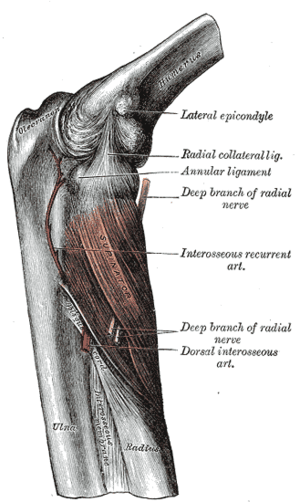Posterior interosseous nerve
The posterior interosseous nerve (or dorsal interosseous nerve) is a nerve in the forearm. It is the continuation of the deep branch of the radial nerve, after this has crossed the supinator muscle. It is considerably diminished in size compared to the deep branch of the radial nerve. The nerve fibers originate from cervical segments C7 and C8.
| Posterior interosseous nerve | |
|---|---|
 The supinator. (Deep branch of radial nerve labeled at upper right and lower right. Dorsal interosseous is this nerve after passing the supinator, at lower right.) | |
| Details | |
| From | Deep branch of the radial nerve |
| Innervates | |
| Identifiers | |
| Latin | nervus interosseus antebrachii posterior |
| TA | A14.2.03.055 |
| FMA | 77559 |
| Anatomical terms of neuroanatomy | |
Structure
Course
It descends along the interosseous membrane, anterior to the extensor pollicis longus muscle, to the back of the carpus, where it presents a gangliform enlargement from which filaments are distributed to the ligaments and articulations of the carpus.
Supply
It supplies all the muscles on the radial side and dorsal surface of the forearm, except the anconaeus, brachioradialis, extensor carpi radialis longus. In other words, it supplies the following muscles:
- Extensor carpi radialis brevis—deep branch of radial nerve
- Extensor digitorum
- Extensor digiti minimi
- Extensor carpi ulnaris
- Supinator muscle—deep branch of radial nerve
- Abductor pollicis longus
- Extensor pollicis brevis
- Extensor pollicis longus
- Extensor indicis
Clinical significance
The posterior interosseous nerve may be entrapped at the arcade of Frohse, which is part of the supinator muscle. Posterior interosseous neuropathy is purely a motor syndrome resulting in finger drop due to no extension of IP joints and radial wrist deviation on extension.
See also
References
This article incorporates text in the public domain from page 944 of the 20th edition of Gray's Anatomy (1918) .